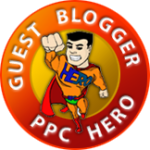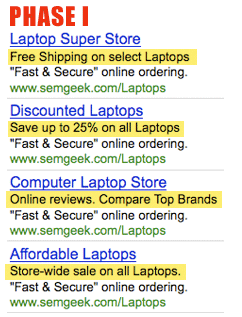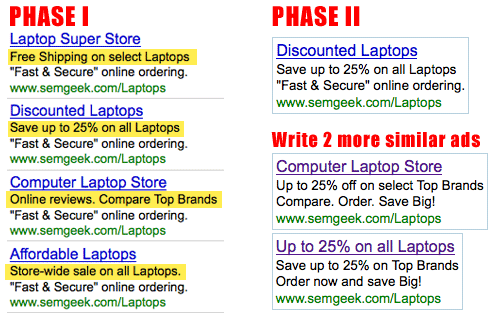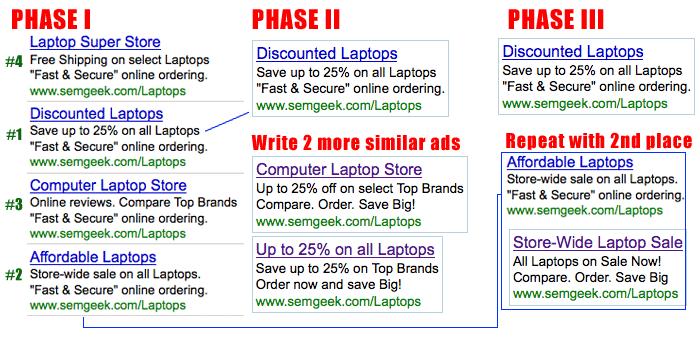 |
This week we are featuring guest articles from our PPC Hero allies! We requested submissions from our readers and we received excellent responses from some great PPC bloggers! The PPC Hero team will return to our regularly scheduled articles next week. Enjoy!
How are you going to figure out what is the best PPC ad/creative in your campaign, if you haven’t identified the fundamentals of attracting the most interest to your product or service offering? In Paid Search Ad/Creative Writing and Testing, these same fundamentals can be traced from traditional Advertising (before the Internet) about how to best communicate the correct messaging that visually and mentally “connects” with the masses of consumers. Let’s discuss…
Suppose you sell Laptop computers and you want to drive qualified traffic to your website. However, the ads that you originally wrote just highlight one (1) offering which in this case would be PRICE. Well, even though price could be a good trigger for clicks, it’s most likely not enough to attract the majority of the search audience interested in laptop computers. Meaning, the searcher may not care so much about price, as compared to selection and warranties. So, obviously you need to identify this and find a way to get them to click and visit your site.
So, in order to attract the “masses”, you MUST take a step back and identify what makes your laptop business better that your competition. Once you do this, every one of these offers could be the difference between a sales and a lost click.
For example, you may have many other offers that may not be important to you but is a deciding factor for the potential customer.
See some examples:
- Competitive Pricing
- New to the market products
- Free Shipping
- Wide variety of top brands
- Lifetime Warranty
- Free 24 support
- Coupons, offers
- Review & Comparisons available
- Customization Features
- And many more…..
Now, this all of these USP (Unique selling propositions), wouldn’t you like to know which of them really convert a customer? Well, what better way to figure this out than to use the power of Paid Search to tell you. But, your probably wondering, how can I figure this out in a short period of time and how long do I have to do this until I find the best Ad. Let me explain.
From my experience, it’s detrimental to write ads/creatives that are too similar to each other because you will not be able to see what really made them click. However, if you tailor each ad to be completely different from each other, you then begin to see the beginnings of a trend, and continuing that trend is the key to refining your message, your clicks (hence quality score) and hopefully your ROI & ROAS. In order to hone in on the process of continuing to improve your messaging, it requires the development of 4 Phases which allow you to react to the behavior and then be proactive to anticipate their behavior.
PHASE I: Segment & Wait
Task: Create 4-5 completely different ads/creatives. Wait until you have at least 30k – 50k in overall impressions and at least 100 clicks. There are many other suggestions in the PPC world as to what is considered a good sample size, but the bottom-line is the more data you have, the better the decision.
Here are some Phase I Ad/Creative Examples:

PHASE II: Identify & Refine
Task: Identify the best ad or ad(s) in the first phase, and then write 2 or 3 more ads based on the same message as the winning ad. This could be adding more emphasis on the message in multiple sections within the Ad (title, line #1, line #2 or even the display url) Run these ads for another 30-50k or at least 100+ clicks to see which Ads performs best.
Here are some Phase II Ad/Creative Examples:

PHASE III: Repetition & Cycling Top Perfomers
Task: Ok, so know you are confident you have maximized 1-2 Ads based on a single Call-to-action, however you may have 7 other offerings that you want to try next. In this situation, I recommend going back to the 2nd place finisher from the Phase I test and star the same process over. However, please note to keep the best performing Ads running, so this does not affect your hard earned Quality Score.
Here are some Phase III ad/creative examples:

In Conclusion:
Maximizing what interests your potential customers is a vital part of a successful PPC Strategy. Furthermore, thinking “outside the box” in deciding (1) HOW you are testing is more important than WHAT or even often how FREQUENTLY you are testing.
Honestly speaking, if you are constantly testing the same Ads over and over, perhaps you are missing the opportunity to make a difference. In that case, I would suggest re-evaluate your business offering to take a step back to see the big picture.
Writing Ads are often overlooked and not given the attention they deserve. In addition to, the value of using what you learn through Google Ad Testing and applying it to OFFLINE advertising initiates is extremely valuable, as we have learned in the 2008, the year of the online election.
Guest Author Bio: Greg Meyers, Partner/Co-Founder of CampaignGrid, LLC and WorldBenefactor and author of PPC Blog www.SemGeek.com



